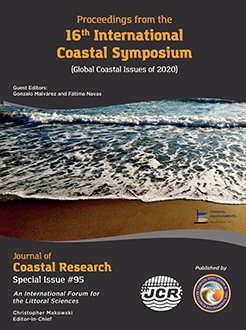Morales, R.; Borrego, J.; Carro, B.M., and Morales, J.A, 2020. Depositional facies along the banks of Guadalquivir Estuary (SW Spain). In: Malvárez, G. and Navas, F. (eds.), Global Coastal Issues of 2020. Journal of Coastal Research, Special Issue No. 95, pp. 573–577. Coconut Creek (Florida), ISSN 0749-0208.
The Guadalquivir Estuary is located at center of the Cadiz Gulf. It is an estuary supplied by one of the longest rivers of Spain. The Guadalquivir estuarine channel extends from the town of Sevilla to its mouth in front of Sanlúcar de Barrameda (Cádiz), bordering Doñana National Park along its southeastern margin. Guadalquivir River has an average discharge of 185 m3/s, with a strong seasonal character. This estuarine zone is characterized by a mesotidal range, with a mean tidal amplitude of two meters. Water usually has a high concentration of suspended matter, being one of the most turbid estuaries in the world. The channel margins mainly develop muddy facies with a clearly visible parallel lamination that has been described and interpreted as a result of the alternation between wet and dry seasons and longer climatic cycles. A zonation of the estuary is suggested as a result of the tidal facies distribution.





